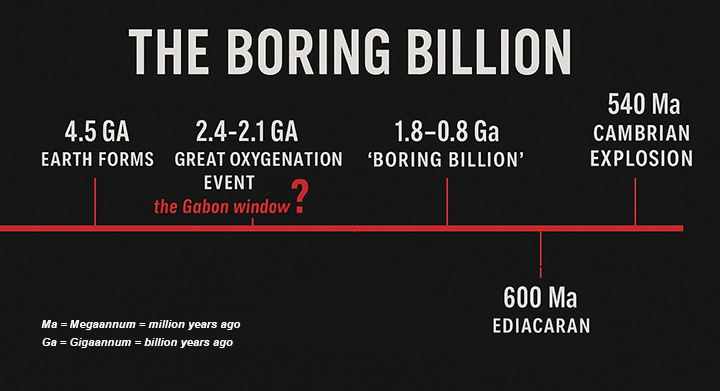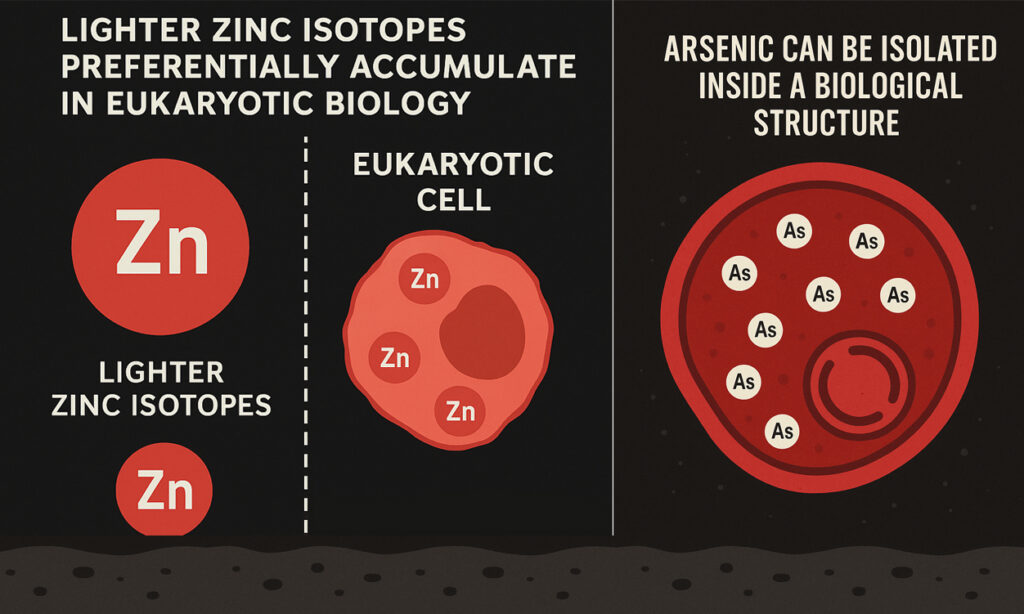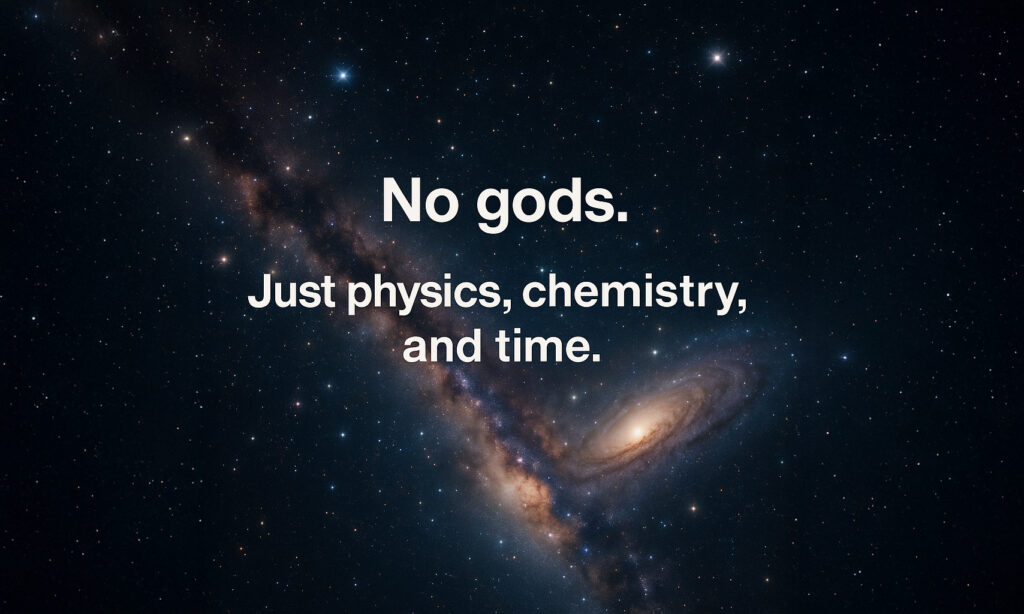
Most of us learn a tidy little timeline in school: simple cells evolve, oxygen rises, complex organisms appear, boom — millions of years of evolution later, you get us, the naked apes who invented TikTok. But what if the story of complex life is less straightforward—and complex life evolved more than once?
A new article in Scientific American suggests something astonishing and, for anyone who insists that life follows a straight, purposeful, divinely ordained line, wonderfully inconvenient. Evidence from deep beneath Gabon, a country in central Africa, implies that complex life may have evolved twice on Earth — once long before the familiar explosion of multicellular organisms roughly 600 million years ago. An earlier attempt, a sort of prototype round of complexity, may have happened 2.1 billion years ago… and then vanished.
That’s enormous. That’s paradigm-shaking. That’s the kind of story that causes creationists to faint gently onto their embroidered pillows.
And for those of us who like our worldview unpolluted by mythology? It’s a feast.
Setting the Stage: A Planet That Doesn’t Care About Our Narratives
When you zoom out far enough — say, past a billion years or so — Earth becomes a place utterly unfit for tidy human stories. The rock record is incomplete. Entire ages of life never fossilized. Entire ecosystems could have existed, thrived, died, and left barely a whisper for us to find.
Scientists traditionally divide early Earth into eras like:
• the Archaean — home of simple microbial life
• the Proterozoic — long, quiet ages where not much seemed to happen
• the Ediacaran — where complex multicellular life finally shows up in recognizable form
• the Cambrian — the famous evolutionary explosion where body plans flourish
But “quiet” doesn’t mean “empty.” “Boring billion” doesn’t mean “nothing happened.” It often just means “the rock we need didn’t survive” or “the right scientist hasn’t cracked open the right stone yet.”
That’s the tension sitting at the heart of the Gabon discovery. It challenges a long-held assumption: that complex multicellularity happened once. One gift, one evolutionary leap, one time.
Nature may have been far more experimental — and far more rebellious — than that.

The Gabon Fossils: Life’s Lost Prototype?
Travel back 2.1 billion years — long before trilobites, long before worms, far before plants or animals. The world looked alien. Oxygen levels had recently spiked, thanks to photosynthetic microbes. Oceans were rich in metals like arsenic and iron. Volcanic activity simmered beneath a nutrient-saturated seafloor.
Now picture yourself drifting through that water. You wouldn’t see fish or coral. But, according to a team led by geochemist Abderrazak El Albani, you might see something stranger: round, lobed, seemingly organized structures. Tubes. Colonial clusters. Things that look like early attempts at multicellular bodies.
These structures were discovered in the Francevillian shale — rock that escaped the crushing metamorphic violence that erases most traces of ancient life. Inside these slabs sits glittering pyrite, shaped into forms that, at first glance, look biological: “tortellini” shapes, string-like tubes, and flattened disk shapes.
So the question is: are these minerals mimicking life? Or fossils representing life’s earliest attempt at large-scale complexity?
El Albani’s team argues for the latter — and they aren’t basing that on vibes or wishful thinking.
The Case for Ancient Complexity: Chemistry Matters
Here’s what supports the biological interpretation:
1. Isotope patterns
Eukaryotes — organisms with complex internal cell structures — tend to prefer lighter zinc isotopes. The specimens show exactly this kind of zinc signature, hinting at biological processing.
2. Arsenic compartmentalization
Some structures show arsenic concentrated inside specific regions — the same pattern you’d expect if an organism were isolating toxins internally. Minerals don’t do selective detox.

3. Environmental context
This ancient basin had oxygen, nutrients, hydrothermal activity, and stable seafloor sediment — a recipe often associated with evolutionary experimentation.
4. Growth-like morphology
While minerals can form weird shapes, the consistency, branching, and patterned repetition in some specimens look more like biological organization than random chemistry.
Put together, the argument is simple: the rocks might be preserving evidence of large, colonial, possibly multicellular organisms way earlier than anyone expected.
Not animals, not plants — something else. Something neither of those categories can comfortably claim as their ancestor. Something that might represent a completely separate experiment in complexity.
Sort of evolution’s beta version.
If This Is Real, the Implications Are Enormous
Let’s assume the Gabon structures are biological and complex. The consequences ripple through evolutionary theory, Earth history, and the entire way we think about life’s trajectory.
1. Complexity is repeatable.
This means multicellularity isn’t a once-in-a-cosmos miracle, but a process that pops up when conditions allow. That’s extremely bad news for “fine-tuning” arguments, and extremely good news for people who like actual evidence.
If complex life happened twice on Earth, it’s likely to happen on other planets too.
2. Evolution isn’t a ladder — it’s a wildfire.
We’re used to imagining evolution as climbing upward toward some grand, inevitable outcome. But this suggests bursts of complexity can flare up, fade, and flare up again. A system less like a staircase and more like a chaotic universe that occasionally stumbles into brilliance.
3. The “boring billion” may have been a creative frenzy.
Maybe we just lacked the right rocks. Maybe the planet was teeming with proto-complex life we never preserved.
Life’s early history could be far more dramatic than we’ve dared to imagine.
4. We may not be descended from Earth’s first complex organisms.
If the Gabon line went extinct, we’re essentially the sequel, not the continuation.
Earth 1.0 may have had a cast we’ve barely got a glimpse of.
5. Astrobiology gets a confidence boost.
If complexity can emerge more than once on a single world, imagine what billions of worlds could do. Complexity becomes a consequence of chemistry and opportunity — not divine whimsy or cosmic luck.
The universe gets a little richer. Religion gets a little smaller.
The Skeptics: The Necessary Anti-Buzzkill

Science isn’t about hyping the coolest idea. It’s ruthless, critical, and allergic to conclusions that arrive faster than the data. And plenty of researchers are not convinced that the Gabon forms are biological.
Their concerns:
Mineral mimics
Pyrite forms weird shapes. Sometimes, unfortunately, biological-looking shapes. Without cells, you can still get curves, rings, and branching.
Fossil ambiguity
A shape isn’t a fossil. A fossil isn’t always the shape you expect. The morphology alone is unreliable.
Missing relatives
If this early complex life existed, where are all the intermediate forms? Where are the rest of its fossils? Why don’t other basins show similar traces?
Scale problems
These Gabon forms are too large and too organized relative to our current understanding of early eukaryotes. Evolution tends to move in increments, not leaps.
Caution fatigue
Researchers have been burned before — ancient “fossils” that later turned out to be mineral quirks. No one wants to be fooled twice.
This skepticism is not only healthy — it’s critical. The more extraordinary the claim, the more evidence must converge.
But skepticism is not dismissal. Many scientists admit that the chemical data is genuinely intriguing. The structures are weird. The context is compelling. They’re not waving the idea away — they’re asking for proof that stands up to centuries.
Science is slow on purpose. It protects itself from fairy tales.
Why This Story Fits Into a Godless Worldview
It’s not just a fun scientific puzzle. It’s an ideological earthquake.
1. Life doesn’t need a script.
Complexity emerging twice — maybe more — underscores a truth: life isn’t driven by purpose. It’s driven by chemistry, chance, and opportunity. There’s no holy hand steering complexity upward; there are just conditions allowing matter to self-organize in astonishing ways.
2. “Creation” looks messy, not magical.
If you were designing life intentionally, you wouldn’t create an early complex lineage, let it die out, wait another billion years, and then try again. That’s wasteful. That’s sloppy. That’s geology’s sense of humor, not intelligent design.
3. Deep time dwarfs mythology.
Most religions operate on timelines of thousands of years. This potential story of complexity rewriting itself spans billions. Earth was doing evolutionary experiments before any prophet, scripture, or sacred story existed.
4. It’s another nail in the coffin of fine-tuning arguments.
The more life emerges spontaneously, the less “special conditions” look divine. Complexity becomes a natural consequence, not a cosmic miracle.
5. It makes reality more interesting than any scripture.
Let’s be honest — most holy texts don’t dare dream of ecosystems rising and collapsing billions of years before humans. Too wild. Too vast. Too indifferent to human ego.
Science, on the other hand? It’s built to embrace strangeness.
And this story is amazingly strange.
The Human Element: Scientists as Deep-Time Detectives
Imagine being El Albani and his team. You’re out in Gabon, prying open slate that hasn’t seen sunlight in over two billion years. You find shimmering pyrite shapes that look alive. Your heart races. You know scientists have spent decades debating the earliest hints of complexity. You know skeptics will come for you — hard.
You publish anyway.
That’s courage. Not in the heroic Hollywood sense, but in the methodological sense: the courage to propose a bold idea and let your peers take their best swing at it. And they do.
Some researchers call the specimens fascinating.
Others call them “curvilinear curiosities.”
Still others want more data — more samples — more confirmation.
Science doesn’t rely on consensus by popularity. It relies on consensus by evidence.
And the story is still unfolding.
What It Means for Us, the Naked Apes With Wi-Fi
The Gabon fossils, real or not, point to an important truth: we don’t know the full story of life. We’re missing chapters. Maybe whole volumes, but just because we don’t know – yet – does not mean some divine being is responsible.

But the search is beautiful. The questions are thrilling. And the idea that Earth may have undergone multiple experiments in complexity makes life look less like a miracle and more like a phenomenon — a natural outcome waiting to happen whenever the chemistry is right.
For atheists, skeptics, rationalists, and lovers of reality, this is the good stuff. This is the universe showing its work. No gods needed.
If the Gabon organisms were truly complex multicellular pioneers, they hint that evolution expresses creativity across time. Not purpose. Not destiny. But potential.
It means:
Life didn’t need a designer.
Life didn’t need guidance.
Life didn’t need perfect timing.
Life just needed a chance — and it may have taken that chance more than once.
And if the Gabon structures turn out not to be life? That’s still progress. That’s still science doing what religion never does: correct itself, refine itself, learn from the evidence, and embrace uncertainty rather than fear it.
In the end, whether these fossils rewrite the origin of complexity or not, they sharpen our understanding. They remind us that the story of life is bigger, stranger, older, and more fascinating than any ancient book ever knew how to imagine.
The universe is not orderly. The universe is not scripted. The universe is not tidy. The universe is experimental, improvisational, and famously indifferent.
And somehow, inside all that indifference, life keeps finding ways to assemble itself.
Maybe twice.
Maybe more.
That’s the beauty of a godless universe: no limits, no boundaries — only the raw, astonishing creativity of nature.
Stay curious, stay skeptical.
Source: Scientific American




